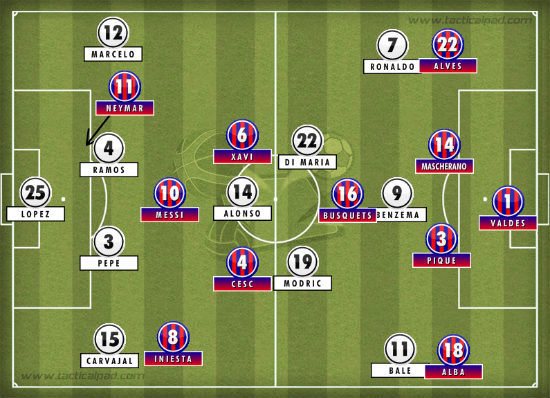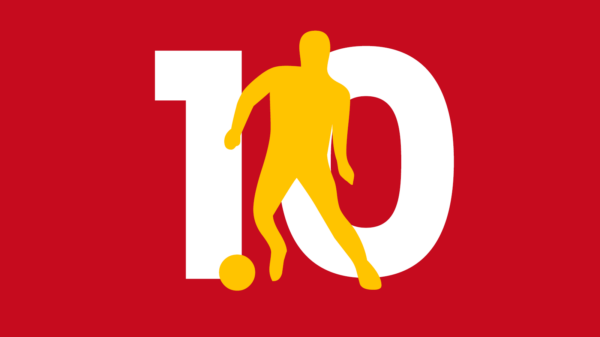One of the fiercest rivalries in World football was resumed on Sunday night as Real Madrid played host to Barcelona in an encounter that had the potential to influence the destination of this season’s La Liga crown. Any match between these 2 isn’t going to be called a dead rubber, but this was one had extra significance in a season which has seen leadership of the league vacillate between not just 2, but 3 different contenders. The Catalans needed to win to stay in the hunt and revive their hopes of retaining their title. For Martino, the clash was important because many felt that his future hinges on the clash. Madrid had the opportunity to go 7 clear of their arch-rivals at this stage of the season, effectively knocking them out of the title race.

Made using Tactical Pad.
Line-ups
Real Madrid: Lopez; Carvajal; Sergio Ramos; Pepe; Marcelo; Alonso; Modric (Morata, 90); Di Maria (Isco, 85); Bale; Benzema (Varane, 66); C. Ronaldo.
Barcelona: Valdes; D. Alves; Mascherano; Pique; Jordi Alba; Busquets; Xavi; Cesc (Alexis, 78); Iniesta; Neymar (Pedro, 69); Messi.
Real Madrid 3-4 Barcelona
Space on the left for Di Maria
Barcelona usually start matches playing a 4-3-3 formation, but they began this in a sort of lopsided 4-4-2. Iniesta or Cesc generally play in an advanced position higher up the pitch. However, Iniesta was played in a slightly deeper role for this game against Real Madrid, while Neymar was deployed on the right side. This meant that Barcelona had 4 in midfield, and these were their 4 best passers. This created an overload in this important region of the pitch, and allowed Barcelona to dominate the proceedings here. However, the lopsided nature of the Barcelona formation also left a lot of space on their right and Real’s left. Alves generally handles a flank all on his own, but on this occasion his defending was poor, and the fact that Marcelo was also bombing forward didn’t help his cause. Neymar might feel that he could have contributed more defensively. Xavi too, was unable to put a brake on Di Maria and really help the defence out.

Di maria finding space on the left hand side. Neymar doesn’t track back, Xavi is unable to help Alves out.
Made using Tactical Pad.
The consequence of all this was that there was a large tract of space on the left hand side of the midfield, and this space was exploited very well by Real’s winger turned central midfielder, Angel Di Maria. The Argentine tormented the Barcelona defence, skipping past players with ease, and creating many dangerous chances. Both of Benzema’s goals were set up by Di Maria, and the Frenchman could have easily had a bigger tally if he had taken his chances. Di Maria completed 7 dribbles in the match, and of his 6 crosses (all of which were from the left) 3 were key passes.

Di Maria’s crosses.
via squawka.com
With Di Maria getting forward in the way he was, Real needed defensive cover at the back to ensure that they weren’t caught out on the counter very easily. Modric was instructed to stay deep and cover in midfield alongside Alonso. There was a point when the usually calm and composed Ancelotti was seen getting this across to Modric in no uncertain terms.
This looked like a promising avenue, but it didn’t continue to be one in the second half for 2 reasons. Firstly, Neymar, who was later replaced by the industrious Pedro, put in a lot more effort tracking back and helping Alves out in the second half. We can presume that Tata Martino advised him to do so. Secondly, the Sergio Ramos sending off meant that Real had to pull back a little, and could no longer attack with the same verve that they showed in the first half.
Real Pressing
Generally, we associate pressing with an aggressive attempt to win the ball deep in the opposition’s defensive zone. However, there are different types of pressing that teams can employ. The aggressive ball winning kind that we see Bayern and Barcelona employ so often, the slightly defensive block that teams use to direct opponents into spaces they leave empty on purpose (Chelsea earlier in the season directed opposition full backs further up the field to break and counter into the spaces vacated by them), and the third, slightly aggressive variety that Real used last night.
This kind of pressing involves marking the opposition’s passing options (especially the immediate ones) without getting too aggressive with the man on the ball. Such pressing is designed to force the opposition into playing loose passes. Specifically for Barcelona, it was a tactic that was to force them into playing longer passes. As you can see in the image above, the 2 Real forwards are close to the short passing options, while Di Maria is with Alves. Eventually, the man on the ball is forced to play it back to the keeper, who plays a poor pass out. The assumption was that if Barcelona were made to play longer passes, Real would have a greater chance of winning the ball back quickly due to their apparent aerial superiority. Sadly for Real, they didn’t manage to make it count, as they gave almost as good as they got, with Barcelona winning 7 out of 16 aerial duels. There were also a number of occasions when Barcelona didn’t have to go long, with their brilliant short passing making up for it (Their 24 pass, 58 second move for Iniesta’s opener is the perfect example).
Of course, a team doesn’t press in one way for the entirety of the match, and most teams vary their approach to winning the ball back depending on the opposition’s phase of play. When Barcelona were becoming slightly aggressive in the build up i.e. every time they played a vertical pass out, a Real player was there to press the man on the ball aggressively. This had some consequences as well, allowing Barcelona to build their counters.
Catalan counters
With Real being aggressive off the ball in the search of victory, Barcelona were reduced to playing on the break, and they adopted this role perfectly. As mentioned above Real did tend to commit numbers forward to try and win the ball off Barcelona. Obviously, this meant that there was a large amount of space left behind the Real forward line, in midfield. This was also the space where Barcelona had stationed their best players, Xavi, Iniesta, Busquets, and Cesc. Messi also dropped into this part of the field quite often, and this gave Barcelona an advantage when they managed to work the ball into these areas. It meant that all these fantastic passers of the football had opportunities to play through balls in behind the Real defence to Neymar more often than not. Barcelona attempted 11 through balls on the night, and not a single one of them failed. It was from such through balls that Iniesta scored and Neymar got in behind the defence leading to Ramos picking up the red card.

Through balls troubling Real Madrid.
via squawka.com
Where does this leave them?
Undoubtedly, the biggest winners on the night were Atletico Madrid. Los Colchoneros have managed to climb to the top of the table with this result, albeit because of their superior head to head record against Real Madrid. They have some crucial games coming up, most of all the trip to the Nou Camp at the end of the season, but for now, their job is to keep going in the same fashion.
Real have lost the battle, but still lead the way in the war. With a relatively easy run in, Real need to ensure that they pick up maximum points. If they do so, and Atletico drop points at Barca on the final day, the title will come to the Bernabeu. It isn’t ideal for Ancelotti and his side, but they still have a very good chance.
Barcelona are now within 1 point of the leaders and any slip up from those 2 will give the Catalans the chance to capitalise. A large part of that depends on which Barcelona choose to turn up on any given day, but if yesterday’s performance can be replicated on a more regular basis, Real and Atletico had better pull their socks up.
For more Tactical Analysis of the biggest games across Europe, head this way.
- Analysis: Are Chelsea’s pressing issues a concern? - October 5, 2020
- Has Financial Fair Play Been Worth It? - August 27, 2020
- Tactical Philosophy: Frank Lampard - May 20, 2020




























































